
Veld, also spelled veldt, is a type of wide open rural landscape in Southern Africa. Particularly, it is a flat area covered in grass or low scrub, especially in the countries of South Africa, Lesotho, Eswatini, Zimbabwe and Botswana. A certain sub-tropical woodland ecoregion of Southern Africa has been officially defined as the Bushveld by the World Wide Fund for Nature. Trees are not abundant—frost, fire and grazing animals allow grass to grow but prevent the build-up of dense foliage.

Erica is a genus of roughly 857 species of flowering plants in the family Ericaceae. The English common names heath and heather are shared by some closely related genera of similar appearance. The genus Calluna was formerly included in Erica – it differs in having even smaller scale-leaves, and the flower corolla consisting of separate petals. Erica is sometimes referred to as "winter heather" to distinguish it from Calluna "summer heather".

The Chamaesaura, also known as grass lizards, are a genus of legless lizards from southern and eastern Africa. The limbs are reduced to small spikes. Chamaesaura propel themselves like snakes, pushing against contact points in the environment, such as rocks, plants and irregularities in the soil. They are viviparous and eat small invertebrates, especially grasshoppers.

Pseudocordylus is a genus of small to large girdled lizards from South Africa, commonly known as crag lizards. Six species of Pseudocordylus are known; they are distinguished from girdled lizards of the genus Cordylus by the presence of granular scales on the back instead of osteoderms.

The German cockroach, colloquially known as the croton bug, is a species of small cockroach, typically about 1.1 to 1.6 cm long. In color it varies from tan to almost black, and it has two dark, roughly parallel, streaks on the pronotum running anteroposteriorly from behind the head to the base of the wings. Although B. germanica has wings, it can barely fly, although it may glide when disturbed. Of the few species of cockroach that are domestic pests, it probably is the most widely troublesome example. It is very closely related to the Asian cockroach, and to the casual observer, the two appear nearly identical and may be mistaken for each other. However, the Asian cockroach is attracted to light and can fly like a moth, while the German cockroach cannot.

Ectobiidae is a family of the order Blattodea (cockroaches). This family contains many of the smaller common household pest cockroaches, among others. They are sometimes called wood cockroaches. A few notable species include:
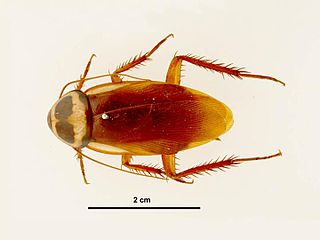
The Australian cockroach is a common species of tropical cockroach, with a length of 23–35 mm (0.91–1.38 in). It is brown overall, with the tegmina having a conspicuous lateral pale stripe or margin, and the pronotum with a sharply contrasting pale or yellow margin. It is very similar in appearance to the American cockroach and may be easily mistaken for it. It is, however, slightly smaller than the American cockroach, and has a yellow margin on the thorax and yellow streaks at its sides near the wing base.

Cockroaches are a paraphyletic group of insects belonging to Blattodea, containing all members of the group except termites. About 30 cockroach species out of 4,600 are associated with human habitats. Some species are well-known as pests.

The blesmols, also known as mole-rats, or African mole-rats, are burrowing rodents of the family Bathyergidae. They represent a distinct evolution of a subterranean life among rodents much like the pocket gophers of North America, the tuco-tucos in South America, or the Spalacidae from Eurasia.
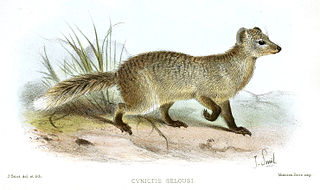
Selous's mongoose is a mongoose species native to Southern Africa. It is the only member of the genus Paracynictis.
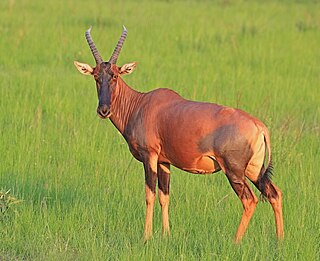
Damaliscus, commonly known as tsessebes, is a genus of antelope in the family Bovidae, subfamily Alcelaphinae, found in Africa.

The Cape genet, also known as the South African large-spotted genet, is a genet species endemic to South Africa. As it is common and not threatened, it is listed as Least Concern on the IUCN Red List. Like other genets, it is nocturnal and arboreal, preferring to live in the riparian zones of forests, as long as these are not marshy areas.

Rüppell's bat, also known as Rüppell's pipistrelle, is a species of vesper bat found in Africa and Asian republics such as Iraq and Israel. It is the only member of the genus Vansonia. It is found in dry and moist savanna, subtropical or tropical dry shrubland, and hot deserts.
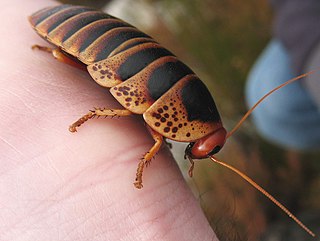
Aptera fusca, the Cape Mountain cockroach, giant cockroach or Table Mountain cockroach, is a large cockroach which is widespread on low vegetation in open areas in the fynbos biome of the Western Cape region of South Africa. Adult females can be from 30 to 40 millimetres long. Males are slightly smaller and have dark brown wings, which are absent in females. It is stoutly built, with a reddish head and brown to black body segments with prominent yellow margins. The femora are heavily spined, with the hind tibiae having two very broad ridges with only two rows of spurs. They are nocturnal and herbivorous. Unusually for insects, it gives birth to 18–24 live offspring and protects the young for a while after giving birth. Family groups are found in late summer and autumn: a brood of black nymphs, a wingless female and two or more males, all living in a hidden crack. When alarmed, it raises its abdomen into the air and squeaks loudly; it also releases a foul-smelling liquid from glands on the back when handled and alarmed, producing an indelible brown stain on skin. The only other species in the genus Aptera, A. munda, is rare, and is found in the Richtersveld.
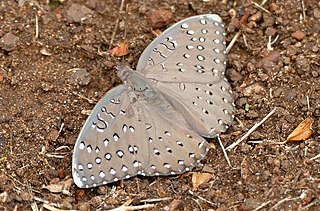
Hamanumida daedalus, the guineafowl butterfly, is a butterfly of the family Nymphalidae and only member of the genus Hamanumida.

Aeropetes is a monotypic butterfly genus in the family Nymphalidae. Its only species, Aeropetes tulbaghia, is commonly known as the Table Mountain beauty or mountain pride. It is native to southern Africa, where it occurs in South Africa, Lesotho, Eswatini and Zimbabwe.

Argyraspodes is a butterfly genus in the family Lycaenidae. It is monotypic containing only the species Argyraspodes argyraspis, the warrior silver-spotted copper, which is found in South Africa, in the Western and Eastern Cape, Free State and Northern Cape.

Chrysoritis nigricans, the dark opal, is a butterfly of the family Lycaenidae found only in South Africa.

Saltoblattella montistabularis is a species of jumping cockroach known only from Table Mountain near Cape Town, South Africa. Both the species and genus were newly described in 2009. Researchers nicknamed the species leaproach. Its jumping mechanism is similar in anatomical features and in performance to grasshoppers with which it shares its habitat. Like grasshoppers, it is able to jump between grass and sedge stems. Its ability to jump is unique among the approximately 4,000 known species of cockroaches. Since the discovery and description of S. montistabularis in 2009 at least 2 more species have been discovered - one from the Cape Cederberg, one from Bredasdorp and a third with black and white stripes from Mossel Bay and Nature's Valley. All these are in the fynbos belt along the southern Cape coast.
Temnopteryx may refer to:



















